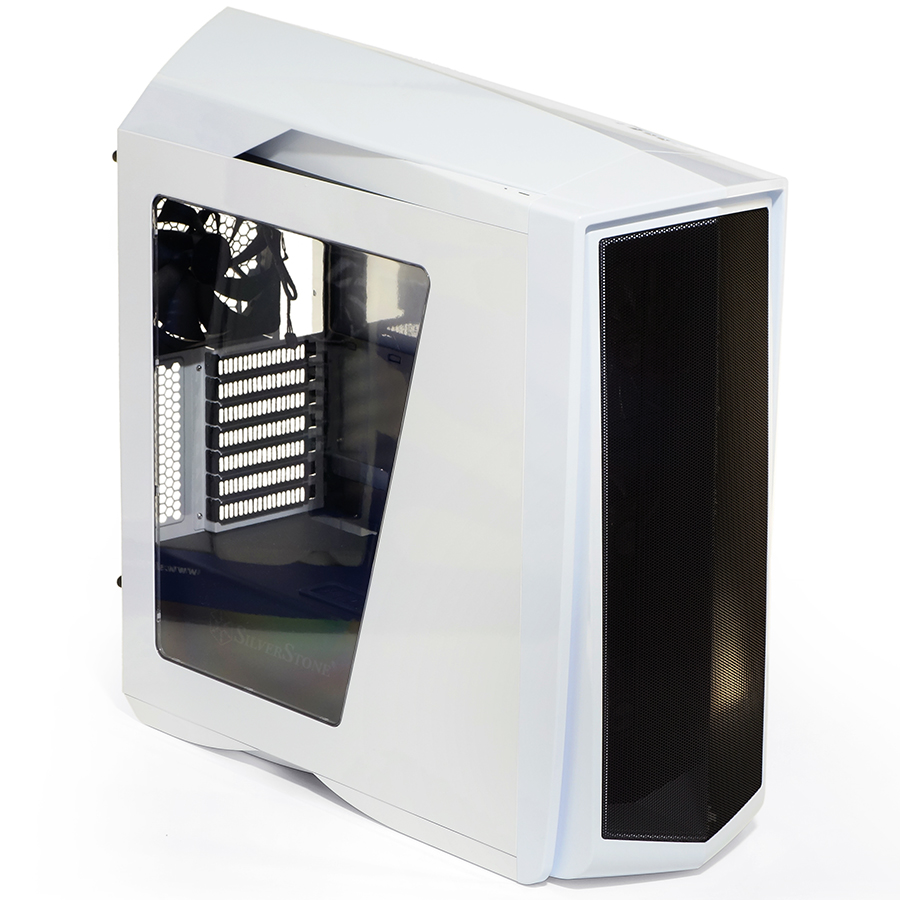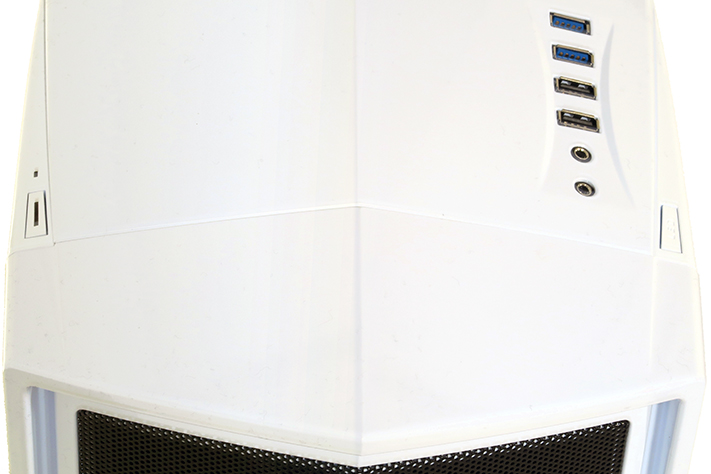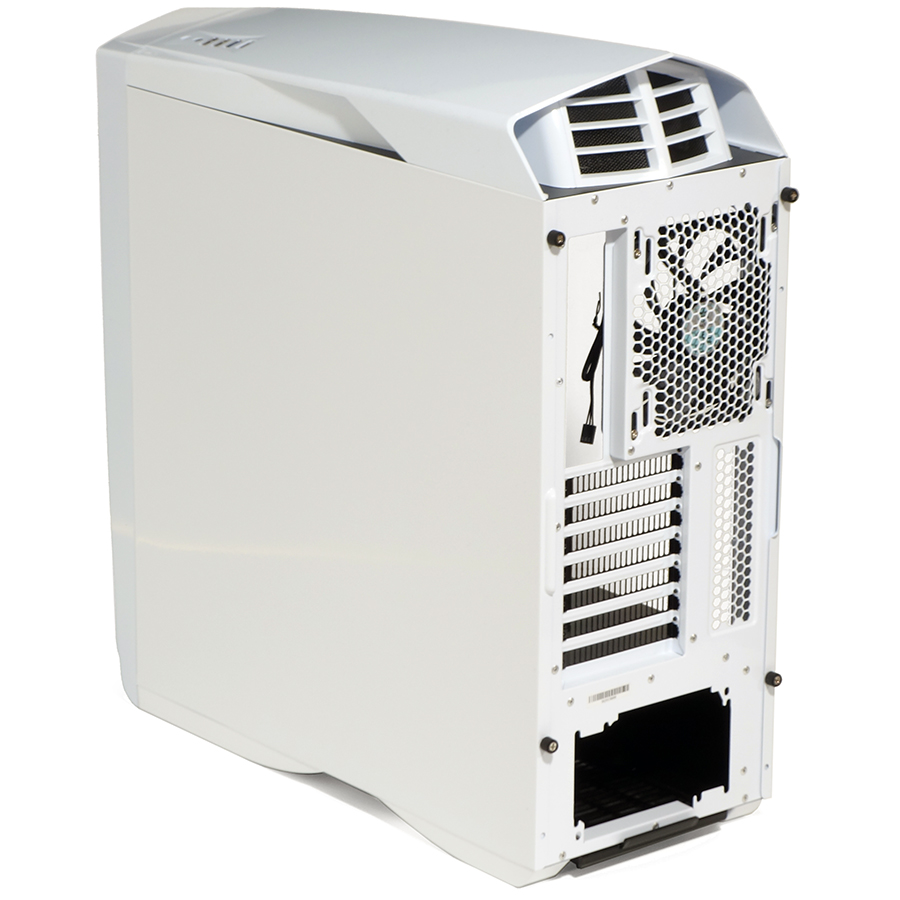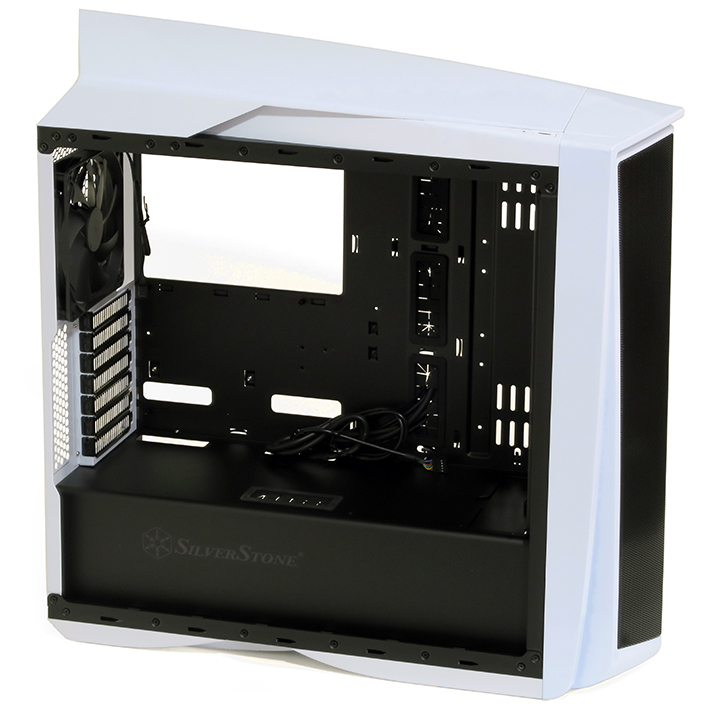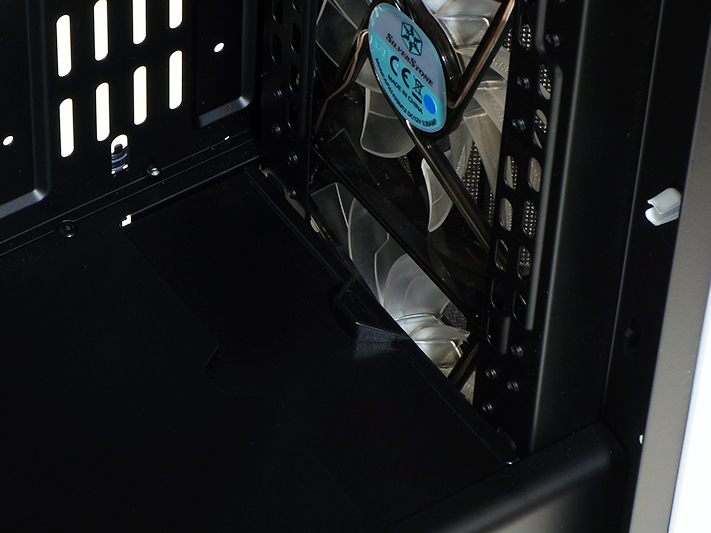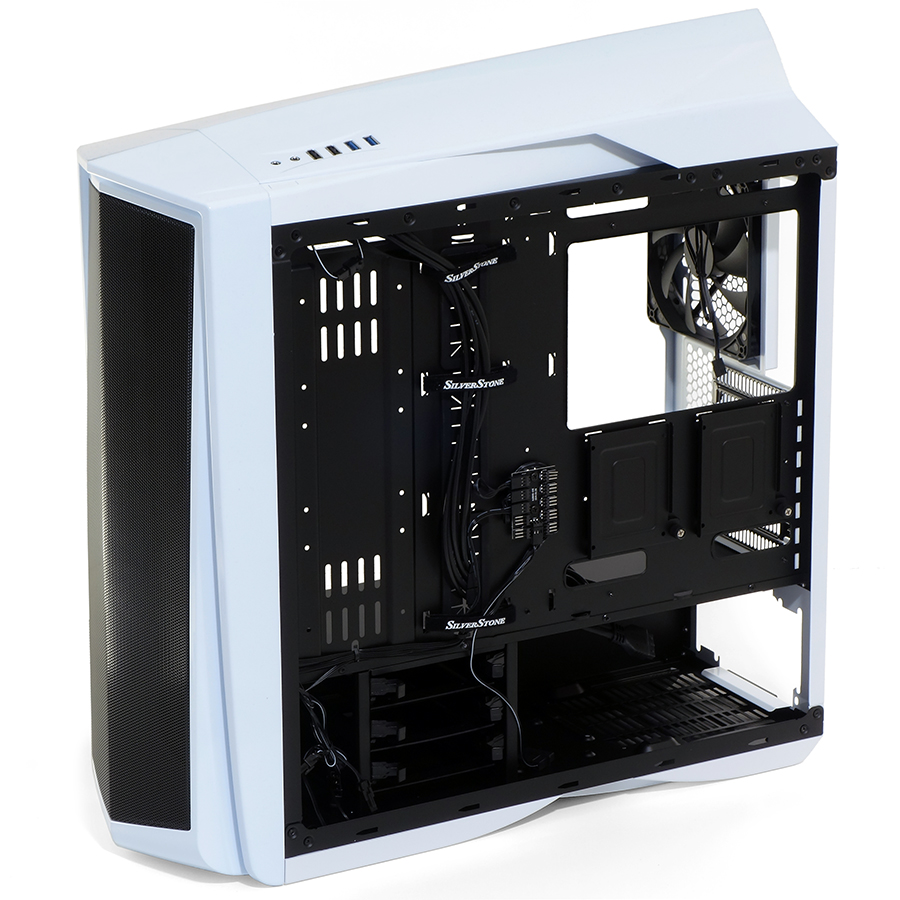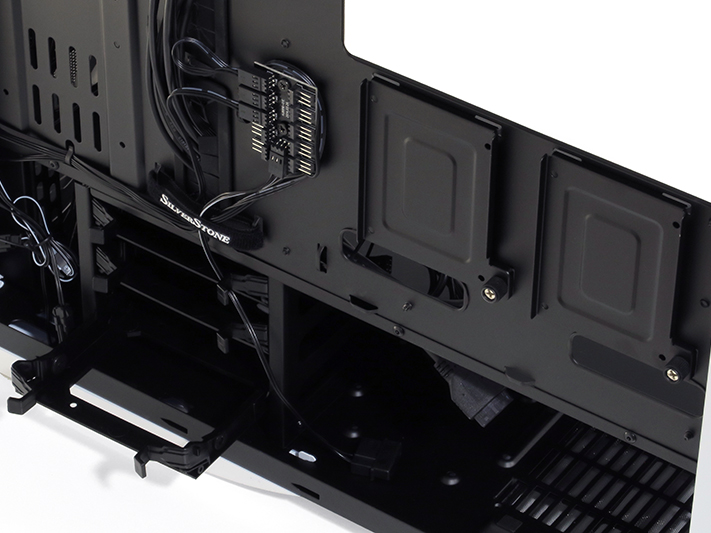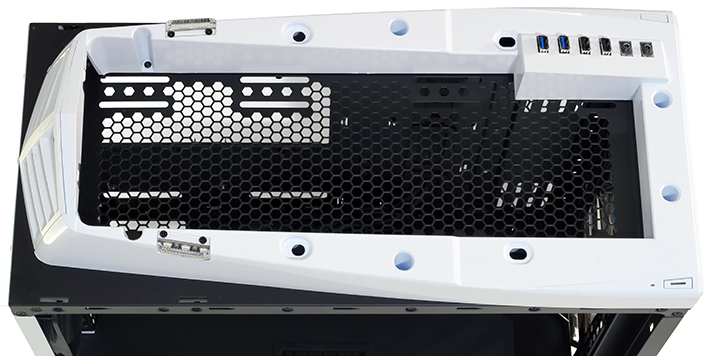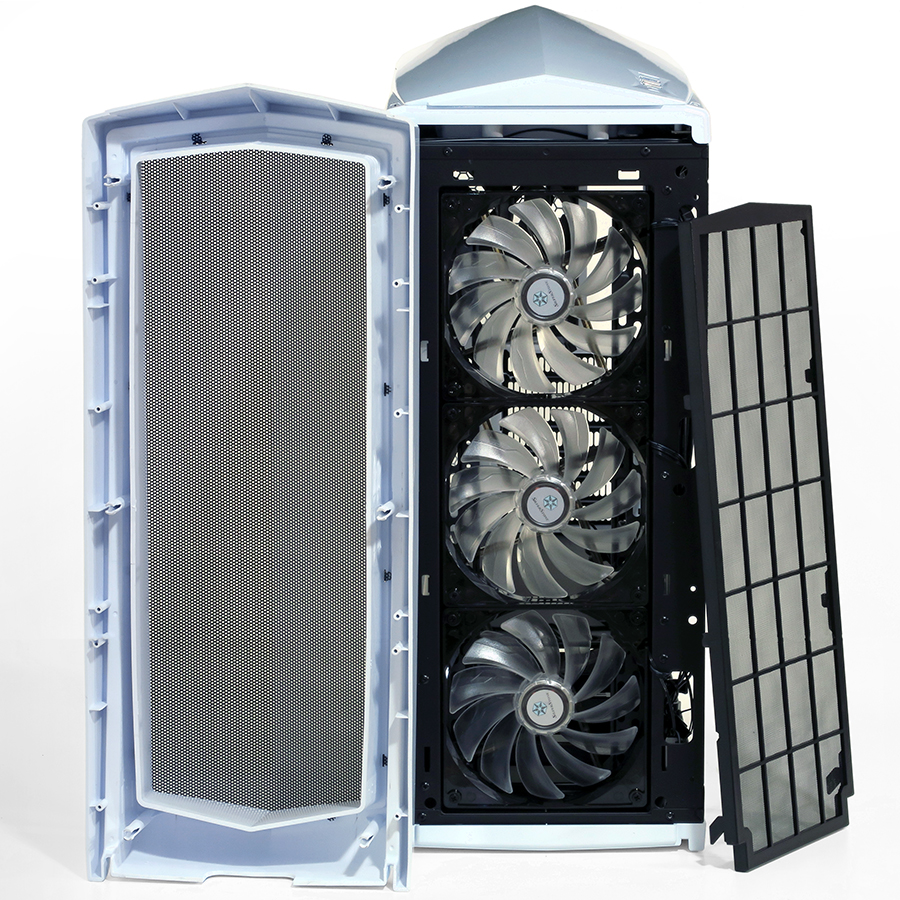Early Verdict
SilverStone’s Primera PM01 is recommended for mid-tower buyers who want the best mix of included features and top performance for under $120.
Pros
- +
Excellent cooling performance
- +
Excellent cooling to noise ratio
- +
Supports a 3x 140mm radiator in front, 3x 120mm on top
- +
Loaded with LEDs for showoffs, plus a switch to disable them
- +
Premium Finish
- +
Moderate Price
Cons
- -
Top-panel radiator installation requires cutting inner panel for coolant lines
- -
No motherboard lead for three-pin fan hub
- -
Power supply shroud and hard drive cage are riveted in place
- -
Single-color lighting
Why you can trust Tom's Hardware
Introducing The Primera PM01 (White)
*Shared on 3.5" tray
MORE: Best Cases
MORE: All Case Content
White cases stand out a little bit in a sea of black ones, but the thing that stands out most about the PM01 is that peak on the back of the top panel. Don’t let the big dimension numbers fool you, because beneath all the hollow plastic sits a fairly traditional ~18.5” mid-tower chassis. The lack of drive bays in front of the motherboard is its main departure from tradition, allowing cards up to 16.7” long and motherboards up to 10.7” deep, and yes, that includes most enthusiast-market boards that are being mislabeled as EATX.
You won’t find any glass, because SilverStone spends its resources on performance-oriented parts, like the extra fans. The company gives this $120 model high-end aesthetics only in its design and ultra-glossy finish. (Note that the Primera PM01 can sometimes be found as low as $105 with a temporary discount.)
Ports include two USB 3.0 and two USB 2.0, with headphone jacks, a case and fan lighting power switch, a system power switch, and two indicator LEDs finishing the so-called front-panel section. I said so-called because, like the PM01, most of the cases we test have these features on the top panel.
A look behind the new Ford GT Primera PM01 reveals that some of that empty space could be useful for a big radiator. The stock 140mm exhaust fan is attached to screw slots. A second set of screw slots is available for a 120mm fan, and both locations allow the fan to be slid up and down for better alignment to the CPU cooler. More importantly, the slots also allow single fan liquid cooling radiators to be moved up or down to gain clearance for end caps and fittings.
Get Tom's Hardware's best news and in-depth reviews, straight to your inbox.
Speaking of slots, the Primera PM01 has only the standard seven expansion slots. Eight would be required for it to get the XL-ATX label, or for builders to put a double-slot graphics card into the bottom slot of an ATX motherboard.
The PM01’s power supply bay is cut and drilled to allow builders to flip over their PS/2-style PSU, and a slide out dust filter protects its air inlet. For those who forgot, PS/2 is the dimensional form factor upon which full-sized ATX (and former AT) power supplies are based. Yes, it’s also a descriptor for the round mini keyboard/mouse port.
A riveted-in power supply shroud runs the length of the PM01, with an access hole near its center to allow the passage of any cables that won’t reach around to other access holes. The entire front section is reserved for liquid cooling hardware, with various mounting holes and slots to fit pump and reservoir brackets.
A door at the front of the power supply shroud slides back 1.8” to allow front-panel radiator installation.
The PM01 has ¾” of space behind the motherboard tray to run cables, most of which must be routed around the two 2.5” drive trays and fan hub. The tray is bent inward at the cable access holes, providing around 1/8” additional clearance for the motherboard’s primary power cable.
In addition to the 2.5” drive trays, the 3.5” trays support 2.5” drives. There’s around 9.8” of power supply clearance between the forward-rolled edge of the back panel and the rearward-rolled edge of the riveted-in 3.5” drive cage: SilverStone quotes 240mm (9.44”) power supply clearance .
A 3-pin fan power hub above the drive cage is powered by a 4-pin ATA to 3-pin female cable. Users who would like to control the speed of fans connected to this header can do so by connecting their own 3-pin to 3-pin fan cable, but doing so requires a fan header with adequate current carrying capability and voltage-based speed control. We’ve seen those listed as “Pump” headers on recent motherboards. The stock fans are rated at 0.30A.
Although the Primera PM01 has only 1.3” of motherboard clearance beneath its metal top panel, the other 1.5” between it and the plastic shell would allow the installation of up to 3x 120mm radiators. A 2x 140mm radiator would fit up there as well, and because the top is tapered, they would get an extra 0.2” of space. I said “would” in both instances because builders are first required to cut holes in the case for their radiator’s coolant fittings, and installing a closed loop cooler within this space would require making the hole large enough for the CPU’s water block to fit through.
The front panel is a more obvious choice for big radiators, as a 3x 140mm unit up to 18.25” long can fit behind the fans without the use of cutting tools. Staggered screw holes with a slightly offset depth make it possible (and actually preferable) to mount the radiator at a slightly different height than the fans, using a second set of screws in different holes.
In addition to its six locating pegs, the front panel is secured with four screws. While screw removal is required to gain dust filter access, nobody will insist that you put the screws back on. The screws are most likely included to reduce the risk of the panel becoming dislocated during shipping.
MORE: Best Cases
MORE: All Case Content
MORE: In Pictures: 40 Unusual Computer Case Mods
- 1
- 2
Current page: Introducing The Primera PM01 (White)
Next Page Hardware Installation, Evaluation, And Conclusion-
Crashman Reply
Hahah, it's like someone looked at the Ford GT and said "Hey, let's translate that design into a top panel cover".19222519 said:it really looks like new ford gt.
-
DookieDraws Reply19223723 said:omg, its the Love Child of an NZXT Phantom and an H440
Yup! I thought the same when I first seen it. It looks like one of NZXT's crazy designs. -
DookieDraws I would like to see more case manufacturers sell the bodies of their cases with various styling options for the sides, top, and front. Hell, even offer various styles for the case feet. Something like the Cooler Master MasterCase 5 offering. Very surprised we aren't seeing much of this these days, and I've wanted to see this for years. Give us more case styling options. Offer us the case body and let us choose the type of styling we want for it.Reply -
Karadjgne Modular cases offered as a build your own style with interchangeable parts other than just the side panel. I could get behind that idea.Reply
